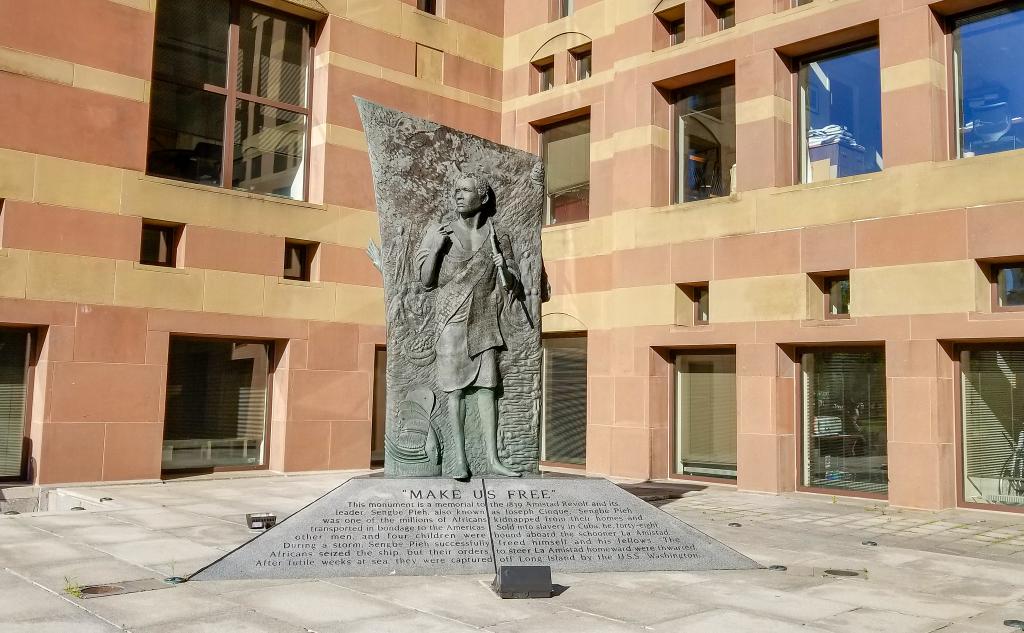
The Amistad Memorial in New Haven stands as a powerful reminder of an important chapter in American history. Located on the former site of the New Haven Jail, this bronze sculpture created by Ed Hamilton in 1992 commemorates the 1839 Amistad Affair, when 53 kidnapped Africans fought for their freedom. This striking 14-foot monument features three sides depicting the capture, trial, and return home of the Africans led by Sengbe Pieh (Joseph Cinque), telling a remarkable story of courage and justice.
When you visit the New Haven Green, you’ll be drawn to this majestic memorial that captures the essence of resilience and the pursuit of freedom. The monument not only honors those involved in this historically significant Supreme Court case but also invites you to reflect on its lasting impact. The Amistad Memorial serves as both an educational landmark and a moving tribute that connects you to the triumph of human spirit over adversity.
Get a discount of 15% to 70% on accommodation in Connecticut! Look for deals here:
Connecticut Hotels, Apartments, B&Bs
Amistad Memorial
The Amistad Memorial stands proudly at 165 Church Street in New Haven, Connecticut. This powerful monument commemorates the historic Amistad slave ship rebellion of 1839 and honors the African captives who fought for their freedom.
When you visit the memorial, you’ll find striking bronze sculptures created by artist Ed Hamilton. The memorial depicts Sengbe Pieh (also known as Joseph Cinqué), who led the rebellion, along with other figures involved in this important historical event. Their expressions capture the struggle for liberty and justice.
The memorial sits near the former New Haven jail where the Amistad captives were once imprisoned while awaiting trial. Your visit connects you directly to this pivotal moment in American history, when the Supreme Court ultimately ruled in favor of the Africans’ freedom in 1841.
This site serves as both an educational landmark and a moving tribute to courage. You can easily include it as part of a walking tour of historic New Haven, as it’s located near other important city landmarks.
Rating: 4.6 (11 reviews)
Location: 165 Church St, New Haven, CT 06510
Contact: (203) 946-8200
Historical Significance
The Amistad Memorial stands as a powerful reminder of one of the most important legal battles in American history. This bronze monument tells a story of courage, freedom, and justice that helped shape the anti-slavery movement.
The Amistad Rebellion
In 1839, a group of 53 Africans were kidnapped and sold into slavery. They were being transported on the Spanish ship La Amistad when they staged a brave rebellion led by Sengbe Pieh (also known as Joseph Cinque). The captives took control of the ship, demanding to be returned to Africa.
Instead, the ship was seized off Long Island by U.S. authorities. The Africans were imprisoned in New Haven, Connecticut—right where the memorial now stands. This was the site of the old New Haven Jail where they awaited their fate.
The rebellion became a symbol of resistance against the horrors of slavery. It caught the attention of abolitionists who rallied to support the Africans’ fight for freedom.
Impact on Abolitionist Movement
The Amistad case went all the way to the United States Supreme Court in 1841. Former president John Quincy Adams argued on behalf of the Africans, and the Court ruled in their favor. This landmark decision declared that the Africans had been illegally captured and had the right to fight for their freedom.
When you visit the memorial, you’ll see the powerful bronze reliefs depicting Sengbe Pieh’s journey from captivity to freedom. The three-sided monument captures different aspects of this remarkable story.
The case energized the abolitionist movement across America. It became a rallying point for anti-slavery activists and helped change public opinion about the institution of slavery itself.
The Amistad Memorial reminds you that New Haven played a crucial role in this pivotal moment in American history.
Design and Architecture
The Amistad Memorial stands as a powerful testament to history through its distinctive three-sided bronze design. This 14-foot sculpture captures the journey of Senghe Pieh (Joseph Cinque) and the Amistad captives in remarkable detail.
Sculptor Ed Hamilton
Ed Hamilton, the talented artist behind this magnificent work, completed the memorial in 1992. His vision brought to life a sculpture that does more than commemorate—it tells a story through bronze. Hamilton chose a unique three-sided approach that allows visitors to walk around the memorial and experience different chapters of the Amistad story.
When you visit, you’ll notice Hamilton’s attention to detail in the facial expressions and body language of the figures. The sculptor spent considerable time researching historical accounts to ensure accuracy in his representation of Pieh and the events surrounding the Amistad affair.
Symbolism Embedded in the Design
Each of the three sides of the memorial represents a significant phase in Senghe Pieh’s journey. As you circle the sculpture, you’ll first see Pieh depicted as a young man in Africa, capturing his life before captivity.
The second side illustrates the trial proceedings, showing Pieh’s fight for freedom within the American justice system. Look closely at the determined expression on his face as he stands before the court.
The third side portrays Pieh after winning his freedom, symbolizing triumph and return. The memorial stands on the former site of the New Haven Jail where the Amistad captives were imprisoned in 1839 while awaiting trial—adding another layer of significance to its location.
Get a discount of 15% to 70% on accommodation in Connecticut! Look for deals here:
Connecticut Hotels, Apartments, B&Bs









